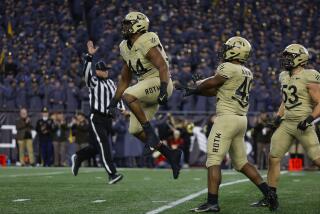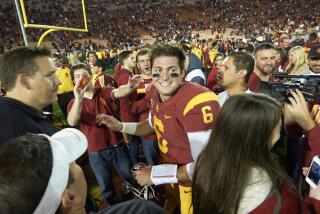Scoreless Tie Foretold Years of Dominance
- Share via
In the years up to and through World War II, the Notre Dame-Army game was a college football classic.
And it was a natural for New York, Notre Dame carrying special appeal for the city’s Irish Catholics and the U.S. Military Academy being just up the Hudson River.
Over the years, the game had been played at three of New York’s ballparks, Yankee Stadium, Ebbets Field and the Polo Grounds. But when the powerhouses met 53 years ago today, it was in Yankee Stadium for the 15th consecutive year.
It was a matchup of the nation’s two top teams. They arrived unbeaten and that’s how they left.
Their scoreless tie is still considered a classic.
The Irish burned to beat the Cadets this day. After beating Army in 1942 and ‘43, the Irish had been steamrollered in 1944 and ‘45, 59-0 and 48-0.
Now, the war was over and Notre Dame had an influx of older athletes, matured by wartime service. At Frank Leahy’s practices in South Bend, Ind., that week the chant during water breaks was:
“Fifty-nine and forty-eight; this is the year we retaliate!”
A formidable challenge. Army had won 25 in a row. Notre Dame had opened with victories over Illinois, Pittsburgh, Purdue, Iowa and Navy.
The usual sellout mob was on hand, 74,000, on a perfect fall afternoon.
It was a stalemate, play after play, all afternoon. The staffs had each other so well scouted, offense became a pointless exercise. Not even Army’s vaunted touchdown twins, Glenn Davis and Doc Blanchard, could shake loose.
Blanchard had his chance to score the game’s only touchdown but was denied on a brilliant defensive play by Notre Dame’s Johnny Lujack.
On a sweep right, Blanchard reached the sideline with no one in front of him. But Lujack, from midfield, made a brilliant, game-saving tackle at the Army 37 to snuff the game’s last scoring threat.
Notre Dame righted itself quickly after the double-zero.
It won its next 21 games, tied USC at the Coliseum in 1948, then won 11 in a row after that.
Also on this date: In 1912, Jim Thorpe and the Carlisle Indian Institute visited West Point, N.Y., and beat Army, 27-6. A casualty that day was Cadet defender Dwight David Eisenhower, who injured his knee trying to tackle Thorpe. The injury eventually ended his football career.
In 1960, the Yankees’ Roger Maris won the American League most-valuable-player award after hitting 39 home runs and driving in 112 runs. He won by three votes over teammate Mickey Mantle.
More to Read
Go beyond the scoreboard
Get the latest on L.A.'s teams in the daily Sports Report newsletter.
You may occasionally receive promotional content from the Los Angeles Times.










